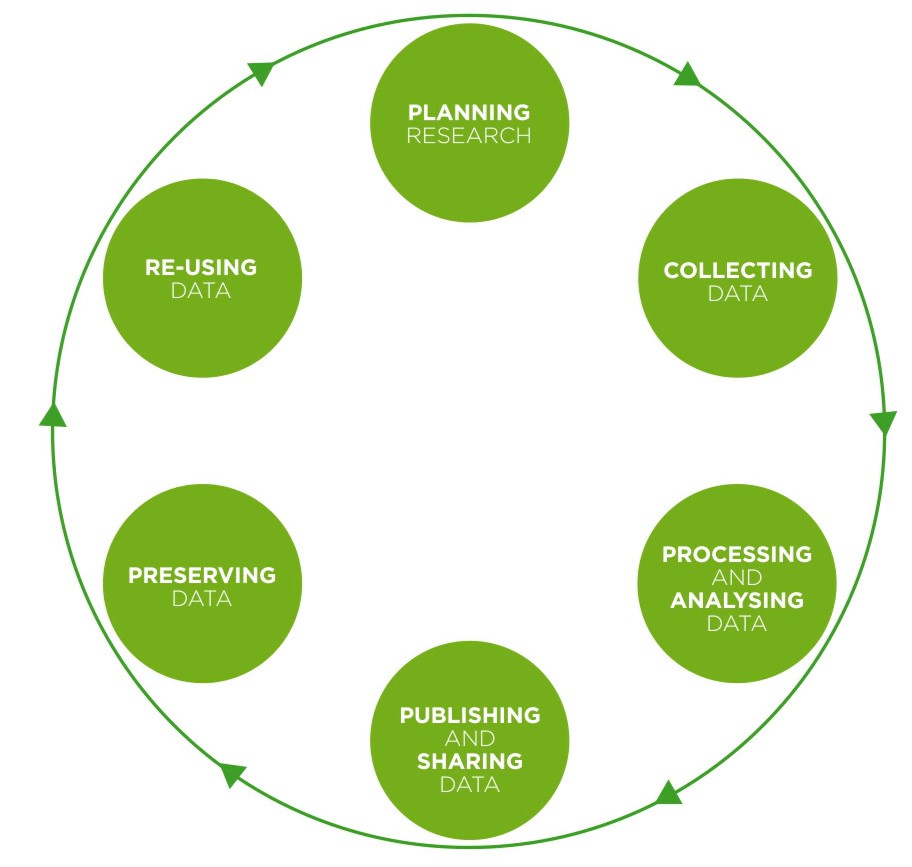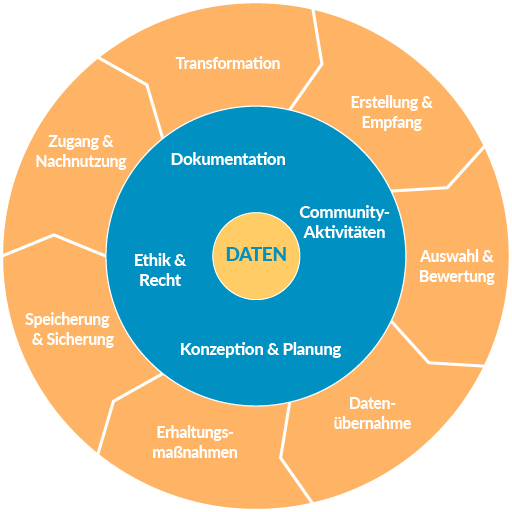Ein Angebot von







Basics
….what is data curation?
Data curation is a highly complex activity that encompasses a multitude of individual, sometimes interdependent, activities. The main focus is always on sustainable and foresighted documentation, organization, and provision of the collected research data, in order to preserve them in the long term and make them reusable for the scientific community.
In many cases, this task is performed by research data centers, which schould address the requirements of comprehensive research data management. To comprehensively capture and describe the associated tasks in data curation, the schematic model of the data curation lifecycle serves as a helpful foundation.
The Data Curation Network offers a platform that provides a wide range of useful information, guidance, and resources for data curation. Additionally, the Research Data Curation and Management Bibliography comprises over 800 selected English-language articles and books covering various topics related to curating digital research data.
…and what is the data curation lifecycle?
While the better known research data lifecycle primarily focuses on the research-oriented perspective of all “phases” of research data, the data curation lifecycle specifically pertains to the process-oriented representation of research data management topics related to curation-specific activities.
The data curation lifecycle used by RDM Compas is based on the original DCC Curation Lifecycle Model, which we utilize to structure our offerings (in a slightly simplified version).
(Original DCLM: Higgins, Sarah (2008): The DCC Curation Lifecycle Model. In: The International Journal of Digital Curation 3 (1), p. 134–140. accessible online via http://ijdc.net/index.php/ijdc/article/view/69)
The center of gravity of the data curation lifecycle are the data. The blue ring represents the ongoing activities that accompany and continuously play a role in all data curation efforts.
In the outer ring, the individual process steps of data curation are depicted, starting from data reception to data transformation. At RDM Compas, these specific curation activities are described in detail within the domain of generic research data management. You will find numerous articles containing information, links, tips, and references related to each curation activity.
…and what is the research data lifecycle?
At first glance, the data curation lifecycle and the research data lifecycle appear to have little difference. However, both cycles emphasize different perspectives: while the research data lifecycle focuses on the smooth execution of entire research projects, the data curation lifecycle allows for the schematic representation of curation-specific activities in the sustainable management of research data.
If you require further information on the research data lifecycle, you can find it in the following article.
In contrast to the data curation lifecycle, the research data lifecycle is clearly research-oriented and serves as an important framework for illustrating the relevant steps in research data management that are crucial in the scholarly handling of research data. It differs, to varying degrees depending on the model, from the curation cycle and serves as a tool for adhering to good scientific practices, such as in the implementation of research projects.
The number and naming of individual stages in the data lifecycle vary depending on the field of study and the content of the research project. Consequently, there are numerous different variants of the data lifecycle in circulation, all of which are valid. Additionally, the distinct treatment of qualitative and quantitative research data can contribute to deviations from the idealized model.
On ukdataservice.ac.uk you can find information on the research data lifecycle and further information on the subject.

Source: https://ukdataservice.ac.uk/learning-hub/research-data-management/#data-lifecycle#data-lifecycle


